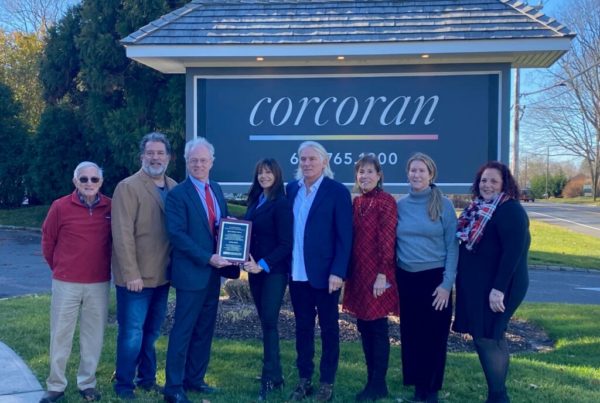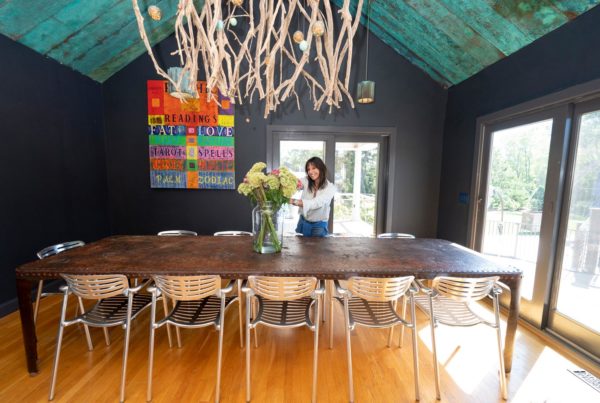Romeo’s Juliet knew that a rose by any other name was still a rose. But what would Shakespeare say about a house by any other name?
Does a house that’s given a sweepingly romantic, creatively quirky, or downright pretentious moniker by its owner suddenly get elevated to a higher status in the minds of others?
“Naming a house makes it more important, as well as the people who live in it,” says author Steven Gaines, whose best-seller, “Philistines at the Hedgerow,” takes a juicy, behind-the-scenes look at some of the Hamptons’ most fabled mansions and millionaires, from the history of The Creeks, Ronald O. Perelman’s 57-acre East Hampton estate, to the “new moneyed” assault on Henry F. duPont’s famed Chestertown House.
If you live in the Hamptons, chances are you’ve driven by a “named” home and either rolled your eyes or chuckled in delight at some of the hoity-toity, creative, or just plain funny titles you’ve seen.
On Georgica Pond in East Hampton, for example, the Steven Spielberg clan lives in Quelle Barn; onBeach Lane in Wainscott, Ronald Lauder resides at his manse, Sweet Potato, while another homeowner on Beach Lane has christened his dream home, Dot.Calm.
Then there’s Old Trees, Cryptomeria, Passing Wind, Brigadune, Onadune, Seven and Seven, By the Sea, and so on and so on.
The list is as long as a summer day in the Hamptons.
The infamous East Hampton mansion Grey Gardens was named for the grey color of the surrounding dunes, the grey hue of the cement garden walls and the grey color of the sea-misted garden. When filmmakers Albert and David Maysles set out to make a 1975 documentary about the eccentric lives of Grey Gardens’s then inhabitants, Edith “Big Edie” Bouvier Beale and her daughter, Edith “Little Edith” Bouvier Beale (aunt and first cousin of Jacqueline Bouvier Kennedy Onassis), they could have chosen a title like “Big and Little Edie.” Instead, they dubbed their cult classic, “Grey Gardens,” after the decrepit, raccoon-infested 28-room estate. The Maysles felt the house-and its name-had as compelling a story to tell as its strange residents.
The idea of naming a home dates back to the 18th and 19th centuries, when country homes were given monikers because towns had no identifying street addresses, says architect Anne Surchin, co-author of “Houses of the Hamptons 1880-1930 (The Architecture of Leisure).”
“It’s an age-old tradition that was exceedingly popular with English country houses,” she explains.
These days, a name can set a home (of any age and pedigree) apart from its neighbors and give it a sense of immediate history. No matter where one lives, a home becomes an extension of its owners.
Judi Desiderio, chief executive officer of Town & Country Real Estate, believes that some people give their home a name because, throughout history, a homestead has always been a treasured investment.
“In `Gone with the Wind,’ Scarlett’s father, Mr. Gerald O’Hara, told his family, `The only thing that matters is land-Tara is what matters.'” Ms. Desiderio said. “I’ve always been inspired by those words.”
Sheri Winter Clarry, a senior vice president at Corcoran Group Real Estate‘s Southold branch, says she’s working with Three Pillars Development to market three homes in Peconic on the North Fork.
“The developers are creating one-of-a-kind homes that tell a story, partly through their names,” Ms. Clarry said. The homes range in price from $1.9 to $2.6 million and feature sleek, modern interiors with exteriors (some with 150-year-old barn siding) that blend in with the North Fork’s agrarian landscape.
Even before the Sheetrock was dry and the first owners move in, the three homes were christened with the names “Rise,” “Pure” and “Light” and had custom-made lettering for each name affixed to their entry pillars.
Paul Brennan, senior vice president of Prudential Douglas Elliman Real Estate in Bridgehampton, says it’s not uncommon for a name to pass on with a house.
“People like to keep names of homes, especially historic estates, as well as phone numbers if they can,” he says.
However, for homeowners who want to tackle the not-so-easy naming process on their own, a variety of sources can be used for inspiration-the family’s name; the home’s location in the country or by the water; distinctive vegetation growing near the house; unique architectural elements; mythological characters; the homeowners’ hobbies and careers; or just flights of fancy.
“As a rule, I believe you should never name your house unless your driveway is at least a quarter of a mile long and your house is 75 years old,” says Mr. Gaines. “Cute house signs are the worst. Your neighbor’s clever little joke wears thin fast. The classy thing is to have your initials, or even classier, just the address.”
Whatever name is passed down or newly christened, chances are there’s a story behind it.
Here’s a sampling of some of those stories, culled from East End homeowners living east and west of the canal:
Carroll House, Wainscott
Over the course of his career, British-born theatrical and film agent Lionel Larner has represented a veritable who’s who of Hollywood and Broadway A-listers, including Anne Sheridan, Bette Davis, Anthony Perkins, Stacy Keach and Dorothy Loudon.
Almost 20 years ago, the Manhattan-based agent set out to buy a country home in the Hamptons, a place to relax from his fast-paced life.
“I always thought that if I had a house, I’d want to give it a name,” says Mr. Larner, who came to theUnited States 50 years ago when director Otto Preminger sponsored him and made him casting director on the film, “Saint Joan,” starring Jean Seberg.
Mr. Larner found his dream house-a 1980s gray-shingled ranch house that he quickly knew he could transform into the lushly landscaped Georgian pavilion that it is today.
What really sold him, however, was the home’s name-Carroll House.
“The then owners were Mr. and Mrs. George Carroll. One of my clients at the time was Carroll O’Connor, and it was mainly because of commissions I earned representing him that I was able to afford the house,” laughs Mr. Larner. “So, I made it a stipulation of the sale that I got to keep the house sign.”
Carroll O’Connor got a good laugh out of the story, and was a guest at the home, along with his wife, Nancy. Glenda Jackson, Diana Rigg, Dorothy Loudon and many other friends and clients who also stayed at Carroll House over the years.
“I’m very superstitious and think it’s unlucky to change a home’s name, just as it is with boats,” he says.
Clamelot, Hampton Bays
Edward Warner, Jr., a bayman and Southampton Town Trustee, and his wife, Kathleen, a sales agent with Prudential Douglas Elliman Real Estate in Hampton Bays, used to live in a small house on Carter Road. But for years they envisioned building their dream house right down the road, on a vacant lot with sweeping views of Shinnecock Bay.
“We used to take our two kids sleigh riding down the hill on the property and tried for many years to buy the lot,” says Ms. Warner. “One day a `For Sale’ sign went up and we were finally able to purchase it.”
They enlisted architect John Himmelsbach and Ironwood Construction to design and build a shingle-style farmhouse that “looked like it had been there for a hundred years.”
In 2003, their new home was christened Clamelot.
Like the mythical kingdom of Camelot, the Warners’ Clamelot strives to be a place of love and happiness. The play on words is appropriate, Ms. Warner says, because “people know my husband’s history as a bayman and that it took a lot of clams to build this house!”
Shorebluff, Hampton Bays
Film buffs will recognize Shorebluff, the charming Dutch Colonial home located on Newtown Road, for its role in the movies, “Margot at the Wedding” and “The Forgotten.”
The home was built for $2,700 in 1897 by Sarah Southgate, the widow of The Rt. Rev. Horatio Southgate, a noted Episcopalian Bishop, and named for its stunning location on the windswept bluffs on the south shore of the Great Peconic Bay.
Since then, five generations of Southgate descendents have lived on the property, which also includes Driftwood, a house built in 1928. Sam and Vivian Garber and their son, Tom Garber-an historical maritime documentary filmmaker-have lived there since 1981.
Shorebluff remains a vestige to the past-still unheated and largely unchanged since its first occupants sat on its porch, looking out at the water 111 years ago.
Final View, Quogue
Some 30 years ago, Jean Newman and her late husband, Bruce, moved into a charming 1932 cottage on Lamb Avenue, right next to the historic Quogue Cemetery. It didn’t take long for them to come up with a name for their little house.
“There used to be a house, now long gone, directly across from the entrance that was called Silent View. So, we decided to call our house Final View and had a sign made with the name and a picture of daisies on it-because if you’re pushing up daisies, you belong in a cemetery,” she says laughing.
Ms. Newman, who was “the first single girl to be a member of the Quogue Field Club,” and her husband, an IBM executive, spent many happy years in Quogue together.
Sadly, Ms. Newman’s mother and husband are now buried in the cemetery next door.
Pianissimo, Quogue
In 1978, Ms. Newman’s neighbors, Richard and Suzanne Prior, moved into their two-story farmhouse on Lamb Avenue. The house had been built in the 1920s by Ross Frederico, the town’s well-known police chief.
Ms. Newman suggested to the Priors that they also give their home a name. After much family discussion, they settled on Pianissimo, a musical term that means “very soft or quiet.”
“We liked that it started with `P’ for Prior, and was a musical term-something important to my kids and I-and had a meaning appropriate for a house that overlooked a cemetery,” says Ms. Prior, who is the director of the Quogue Junior Theater Troupe. “Unfortunately, after we put the wooden sign up by our front entrance, some people thought the Priors had moved out and the Pianissimos had moved in.”
Ms. Prior still laughs about that.
On the Lamb, Quogue
Down the street a bit, another Lamb Avenue neighbor, Lili Whitmer, and her husband, Bob, live in On the Lamb, a 19th century charmer they moved into in 1998 and share with their dog, Lulu.
Ms. Whitmer’s great-grandfather put down roots in Quogue in 1880 and her father was born onQuogue Street in 1902, so she is quite familiar with all the “Q” house names in “quaint, quiet Quogue.”
“We do have a 1958 Morris Minor convertible in our garage with Connecticut license plates that read, `Quoget,'” she says. “But we wanted to find a different kind of name for our house.”
Inspiration hit one hot August day when she was stuck on the Long Island Expressway with an overheated car engine.
“I was listening to CBS radio and heard that there had been a bank heist in New York City and that the perps were on the lamb. And I thought, `That’s it.’ We’ll call our house `On the Lamb’ for the street we live on.”
With his typical insight, Steven Gaines believes there might be some other house signs going up around the Hamptons this summer.
“I think they’re going to say, `Chapter 11.'”








